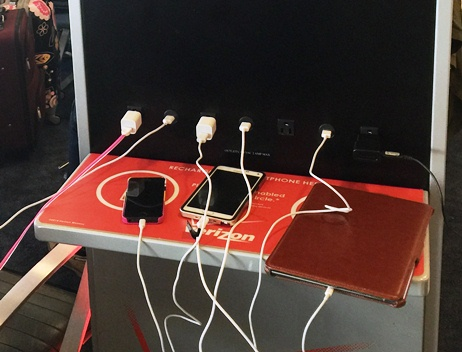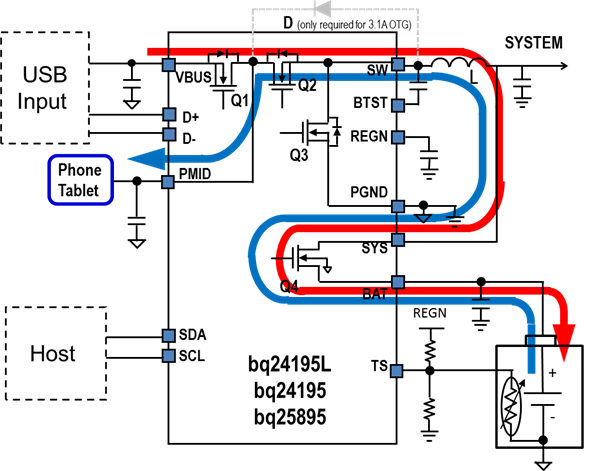The processor in a smartphone or a tablet requires more and more power to deliver high performance. Additionally, the around-the-clock usage of portable devices requires more battery capacity. The high power consumption of a smartphone or a tablet and the limited capacity of the embedded battery generate power anxiety for users.
Figure 1 is a picture I took at the Chicago O’Hare International Airport charging station. Many people were watching both their charging percentage and the time to make sure that they didn’t miss their flight.
Figure 1: A charging station at Chicago’s O’Hare International Airport
A power bank is a portable secondary battery that stores energy when AC power is available and can charge a smartphone or a tablet to replace the AC adapter. Power banks are one of the most popular personal accessories these days.
A two-stage power bank has one single-cell battery charger to step down the adapter voltage to charge the battery, followed by one boost converter to step up the battery voltage to USB-compliant 5V. Two sets of switches and inductors are required to perform the charging and boost separately. Texas Instruments has developed a full range of power-bank IC solutions that require only one set of switches and an inductor to perform both charging and boost functions. The idea is to operate the boost with reusing the set of switches and inductor for charging, since charging and boost don’t happen at the same time.
The bq24195/195L and bq24295 are still ideal for solutions up to 2.1A. The newly released bq25892 with MaxCharge™ technology pushes the boundaries of efficiency and thermal performance. The blog “MaxChargeTM Technology – Faster Charge with More Mobility” shows the features of faster, cooler and safer charging. The bq25895 not only achieves up to 5A fast charging but also takes the boost current to 3.1A, making simultaneously charging both a smartphone and a table possible. Solve your technical challenges with these solutions:
- Mobility: TI’s power bank ICs are single-chip fully integrated solutions. Compared to the two-stage approach, the solutions shown in Figure 2, the bq24195L, bq24195 and bq25895, combine both charging (red trace) and boost operation (blue trace) into one chip with only one inductor required. A single-chip solution not only reduces the size of the power bank, but also the total bill of materials (BOM) cost.
Figure 2: Fully integrated single-chip power bank solution
- Safety: Battery charging and discharging safety are major concerns. TI solutions offer many layers of protection, such as overvoltage protection during the boost operation. The charging voltage is accurately controlled within ±0.5% crossing temperature range.Figure 2: Fully integrated single-chip power bank solution
- USB D+/D- detection: The charger can detect a USB host or charging port and is compatible with USB battery-charger specifications.
- High efficiency: Synchronous boost operation achieves better efficiency than nonsynchronous operations. The 500 kHz and 1.5MHz switching frequency of the bq25895 offers the option to minimize the power loss at different boost current levels.
- Low electromagnetic interference (EMI): Optimized driver circuits for both buck charging and boost to minimize EMI.
These fully integrated power-bank ICs with high conversion efficiency, capable of 1A to 3.1A backup charging current, deliver a compact design and a high level of safety. Consider incorporating these solutions in your next mobile power design and eliminate battery anxiety.
Additional resources
- Check out these TI Designs reference designs:
- I2C Controlled Single Cell Chargers with 5.1V Boost Operation : bq24195/2.1A and bq24195L/1A
- I2C Controlled Single Cell 5A Fast Charger with MaxCharge and 3.1A Boost Operation for Power Bank
- Check out these TI single-chip power bank solutions:


